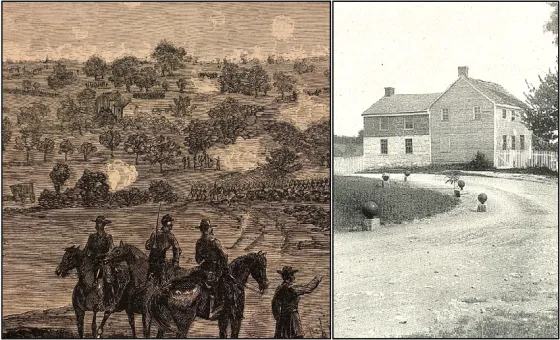American Battlefield Trust Saves 49 Acres at Gettysburg, Including Historic McKnight
(Gettysburg, Pa.) — The nation’s leading battlefield preservation organization has protected another 49 acres on the country’s most famous battlefield. Among the parcels recently purchased by the American Battlefield Trust is the historic James McKnight House, located along the Baltimore Pike near East Cemetery Hill. But thanks to the Trust’s acquisition, all three properties will be saved from development threats encroaching on the edges of Gettysburg National Military Park.

“If any battlefield is universally considered ‘hallowed ground’ by Americans, it is Gettysburg, where president Abraham Lincoln coined the phrase,” said Trust President David Duncan. “This is a place quintessential to the American experience and it is our privilege and honor to ensure that it remains a sacred place of memory and contemplation for future generations.”
Cumulatively, the Trust has protected 1,231 acres across the Gettysburg landscape, representing important action from all three days of the July 1-3, 1863 battle — the bloodiest engagement of the Civil War and a moment widely considered a turning point of the conflict. The 49 acres most recently protected include a 47-acre parcel near Big Round Top that was a prime location for a housing subdivision of large-lot “McMansions,” construction of which would have intruded on views from across the battlefield.

Two small adjacent parcels along Baltimore Pike near East Cemetery Hill — adjacent to McKnight’s Hill or Stevens Knoll, an area of the battlefield set aside for preservation in the 1860s — were also purchased. One lot consisted of the historic James McKnight House, a landmark on this portion of the field. Tens of thousands of Union troops — up to a third of the Federal army — marched along the road past this property on July 1 and 2. Notable fighting occurred here on the evening of July 2, as the 5th Maine Light Artillery helped to stymie a fierce Confederate assault against East Cemetery Hill long enough for reinforcements to arrive on the scene. Period documentation also demonstrates that Union casualties were temporarily interred all around this property prior to the opening of the Soldiers’ National Cemetery, the ceremony at which Lincoln delivered the Gettysburg Address in November 1863. Both small lots were zoned “village mixed use,” allowing for commercial development, and there were no protections or easements on the McKnight House.
The Trust announced the three projects last year and completed the purchases by leveraging private donations from Trust members against matching grants from the federal American Battlefield Protection Program. This mechanism promotes preservation of significant Revolutionary War, War of 1812, and Civil War battlegrounds by making use of monies from the Land and Water Conservation Fund to encourages private sector investment in historic preservation. During an event at Gettysburg last May, then-Secretary of the Interior David Bernhardt announced $573,000 in federal funding for two of these three properties.
The American Battlefield Trust is dedicated to preserving America’s hallowed battlegrounds and educating the public about what happened there and why it matters today. The nonprofit, nonpartisan organization has protected more than 53,000 acres associated with the Revolutionary War, War of 1812 and Civil War. Learn more at www.battlefields.org.
###




